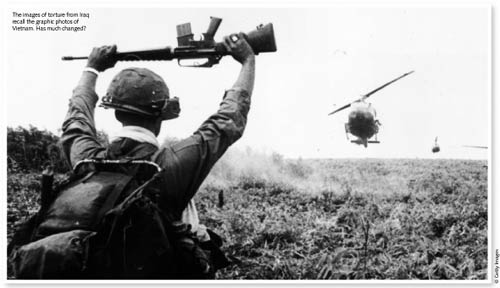From Abu Ghraib to New York, Interview with Brian Wailis
Amateurs using digital technology have provided us with a new look at the horrors of war, Rob Hirsch investigates…
Interview with Brian Wailis by Robert Hirsch
From Digital Camera Magazine, No. 29, pg 24.

The United States led invasion of Iraq has produced some astounding photographic examples. Live, enthusiastic dispatches from embedded reporters have given way to video taped executions of civilians, which were broadcasted on television and available online. However, the photographs that have most deeply assaulted the American consciousness have been gritty images of US soldiers abusing Iraqi prisoners and these were digital photographs.
Previously, print media photojournalists, from Robert Capa to Larry Burrows, brought home the horrifi c photographic evidence of war. Now with digital means, nonprofessionals are making attention grabbing war images.
The Andy Warhol Museum in Pittsburgh, PA and the International Center of Photography (ICP) in New York City have concurrently presented ‘Inconvenient Evidence: Iraqi Prison Photographs from Abu Ghraib,’ featuring 17 of these amateur snapshots (unframed) and four framed photographs refl ecting Iraqi civilian response to these images. To learn more about the relationship between photography and war, I spoke with Brian Wallis, ICP Director of Exhibitions and Chief Curator.
When do you place these photographs within the history of photography?
We wanted to reference the amateur history of ‘bystander’ photography by juxtaposing them with the Zapruder fi lm of the Kennedy assassination and with 911 and the ‘here is new york: a democracy of photographs’ exhibition (http://hereisnewyork.org/).
How has the presence of women affected these photographs?
The women give the pictures an extra shock. We see a petite woman holding a man by a leash and another woman with an all American grin posed next to a dead Iraqi. The abundance of testimony from the perpetrators and the victims reveals it was part of the humiliation and torture strategies.
What occurs when these snapshots are presented in a museum context?
I wasn’t interested in the “this is art aspect” that museums seem to apply, so we presented them in an informal manner. You have to exist in the space with them with other people. There’s a public experience that changes their effect. Plus there’s a contemplative aspect; people pause and look at them more closely than in a media context.
How would you compare these photographs to the ‘scripted’ kidnapping and murder videos of the Muslim extremists?
In terms of their pictorial interest, I think those tapes are the exact opposite of these extraordinary snapshots. The photos magnify the horror by pictorial means. There’s not just a dead body, there’s a body juxtaposed with a smiling, female soldier who seems oblivious to what’s really happening.
How do you respond to the critique that within the museum such pictures blur the boundary between documentation and artistic expression?
Such confusion between genres is no longer surprising. Some photographers have challenged, or deliberately confused those genres. Now viewers are more aware that things are flexible and tend to read images in more ways than one. These snapshots don’t have to be represented as ‘documentary’ photographs, to be truthful.
Why present the images so soon after Hersh’s article ‘Torture at Abu Ghraib’ in the 5th May issue of The New Yorker?
There was a deliberate suppression of the images with the government trying to make the story go away. I wanted to get these images, that offer a different view of the war, back into circulation so people would talk about them again.
For more information visit: www.icp.org
![]()
